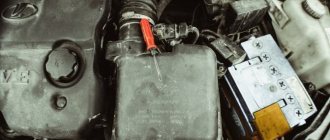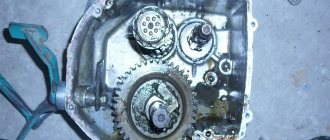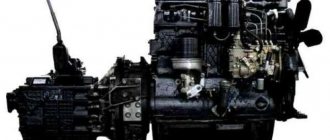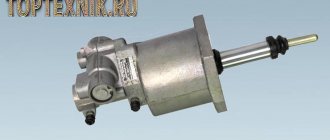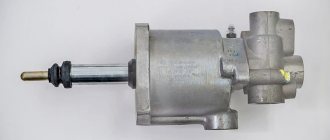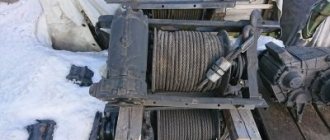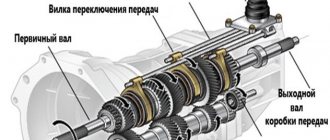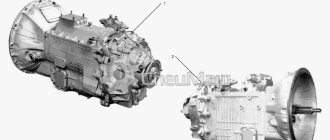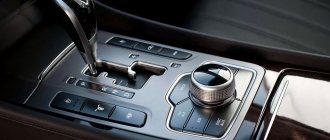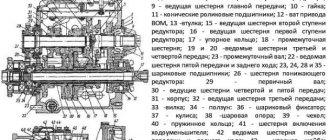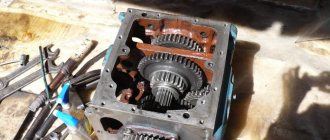The design and principle of operation of a car clutch
A clutch is a transmission mechanism that transmits torque from the engine to the gearbox through friction. It also allows you to briefly disconnect the engine from the transmission and reconnect them smoothly. There are quite a few types of clutches. They differ in the number of driven disks (single disk, double disk or multi-disk), the type of operating environment (dry or wet) and the type of drive. Different types of clutches have their respective advantages and disadvantages, but the most common on modern cars is the single-plate dry clutch, either mechanically or hydraulically driven.
What is the difference between a dual-clutch transmission and an automatic and manual transmission?
Let's try to figure out what this outlandish creation of engineering is. The very concept of double clutch suggests that such a design involves the presence of two components.
That’s right, this type of clutch is distinguished by the presence of two driven friction discs, but not everything is as simple as it might seem at first glance.
The presented type of mechanism works in tandem with robotic gearboxes. In this case, we are talking about twin gearboxes, which are responsible for turning on a certain set of speeds. One is responsible for odd transmissions, the other for even ones.
Perhaps the defining difference between a dual-clutch gearbox and all others is the presence of a so-called double shaft. To some extent, it represents the same gear block of a more sophisticated design.
The gears on the outer shaft of such a gear unit mesh with the gears of the even-numbered gears, and the gears of the so-called inner shaft interact with the gears of the odd-numbered gears.
The presented transmission units are controlled thanks to a system of hydraulic drives and automation. It is worth noting that the presented type of gearbox, unlike automatic transmissions, is not equipped with a torque converter.
In this case, it is customary to talk about two types of clutch: dry and wet. We will discuss them in more detail below in the text.
Clutch elements
The standard clutch used on most vehicles with a manual transmission includes the following main elements:
- The engine flywheel is the drive disk.
- Driven clutch disc.
- Clutch basket - pressure plate.
- Clutch release bearing.
- Clutch release clutch.
- Clutch fork.
- Clutch drive.
Friction linings are installed on the clutch driven disc on both sides. Its function is to transmit torque due to friction. A spring torsional vibration damper built into the disk body softens the connection with the flywheel and dampens vibrations and loads from uneven engine operation.
Layout of the clutch disc, basket and release bearing with release clutch
The pressure plate and diaphragm spring acting on the driven clutch disc are assembled into a single unit called the “clutch basket”. The clutch driven disc is located between the pressure plate and the flywheel and is connected to the transmission input shaft using splines along which it can move.
The diaphragm spring of the basket can be of either a push or pull principle of operation. The difference is in the direction of application of force from the clutch drive: to the flywheel or from the flywheel. The design feature of the extension spring allows the use of a basket whose thickness is much smaller. This makes the unit as compact as possible.
Disadvantages of a dual clutch gearbox
The new stage in the practice of developing and implementing designs with two groups of clutch mechanisms is due to several positive aspects:
- Fuel economy. Research shows that even compared to a conventional 5-speed automatic transmission, such mechanisms can reduce fuel consumption by 10%.
- Smooth ride. Due to the absence of complete disconnection of the engine from the drive wheels, jerks and vibrations are avoided, which also adds to the attractiveness of such mechanisms in the eyes of the consumer.
- Increased dynamics. It should be noted that initially the principle of operation of the clutch with separate groups of friction elements was used on racing cars, including due to the higher speed. But why does the average car enthusiast need double clutch release? In a regular passenger car, the driver can get not just increased dynamic capabilities, but also more reliable control. This especially applies to models with powerful engines up to 200-300 hp, which become more manageable.
- Possibility of manual and automatic switching. As a rule, the user can use different control modes, including semi-automatic.
Time has passed, progress has dictated new technical requirements, and what recently seemed perfect today does not stand up to criticism. This happened with automatic transmissions; over time, classic automatics began to compete with more advanced transmissions, including a CVT and a dual-clutch automatic. By the way, if anyone is interested in whether a CVT or an automatic transmission is better, read this article.
After its appearance, the double clutch, like the automatic transmission, was criticized by skeptics, and some simply did not know what it was and “what it’s used with,” perhaps that’s why they were afraid to buy a car with such a gearbox. Today, this invention has millions of fans and boasts excellent characteristics, although, as always, there are those who still do not understand what a dual-clutch transmission is and how it differs from a regular “automatic”.
Read more: What is a light sensor in a car? Operating principle real video
The main difference between a dual-clutch automatic transmission and a conventional automatic transmission is the smoothness of operation, which can only be provided by a CVT.
- The design with two alternating shafts allows you to achieve maximum smoothness when driving.
- Gear changes are carried out in the shortest possible time (up to 0.12 seconds).
- Maintains torque without noticeable losses when switching.
- Reduced fuel consumption (even in comparison with manual transmission).
- High dynamics during acceleration.
However, not everything is so good. Some of these disadvantages of a double-clutch transmission will be called insignificant, for others this will be one of the main conditions for postponing the purchase of a car with such a transmission device. Among the most significant are:
- A small resource, if you treat it with care, then 60 - 80 thousand kilometers there will be no problems.
- The design of some gearboxes is much more complex than the available options for automatic and manual transmissions.
- Few auto repair shops will be able to competently provide repair services of such technology.
- Due to expensive materials, repairing a dual-clutch transmission will cost its owner a tidy sum.
The photo shows the DSG gear shift knob in the Skoda Kodiaq crossover.
Principle of operation
The principle of operation of the clutch is based on a rigid connection between the clutch driven disc and the engine flywheel due to the frictional force generated by the force created by the diaphragm spring. The clutch has two modes: “on” and “off”. Most of the time the driven disk is pressed against the flywheel. Torque from the flywheel is transmitted to the driven disk, and from it through a splined connection to the input shaft of the gearbox.
Diaphragm spring operation diagram
To disengage the clutch, the driver presses the pedal, which is connected to the fork by a mechanical or hydraulic drive. The fork moves the release bearing, which, by pressing on the ends of the petals of the diaphragm spring, stops its pressure on the pressure plate, and it, in turn, releases the driven one. At this point, the engine is disconnected from the transmission.
Mechanism design
To become more familiar with the presented unit, it is necessary to study the structure of the mechanism itself, which ensures smooth gear shifting.
Unlike all other types of clutch, this type is distinguished by the presence of a number of unique components and elements.
So, this system includes the following key components:
- friction disc package;
- housing with dry or oil sump;
- mechatronics
If the first two nodes are quite familiar to car enthusiasts, then the third gives the impression of something hitherto unknown.
So, mechatronics is a high-tech clutch unit that allows you to convert electrical signals into the mechanical operation of actuator units.
The mechatronics of a modern car, as a rule, includes two components: an electromagnetic unit and a control board.
The first is a set of solenoid valves, so-called solenoids. Previously, instead of solenoids, hydraulic distribution mechanisms, the so-called valve blocks, were used. But due to their low performance, they were replaced by more advanced electromagnetic devices.
Let's look at the fundamental features of wet and dry clutches.
"Wet" double
If we take an excursion into the history of the node in question, then the so-called “wet type” is considered to be the progenitor of the double node.
It is a set of two sections of ferodo discs immersed in an oil bath in the clutch housing.
In this case, it is customary to distinguish between two types of “wet clutch” depending on the type of vehicle drive. So, for front-wheel drive cars, a clutch with a concentric arrangement of ferodo discs is used. For owners of rear-wheel drive cars, the peculiarity of this device is manifested in the parallel arrangement of the driven disks.
The components of both types of “wet clutch” are the same. These include:
- inlet flange;
- main flange;
- drive disk;
- package of first and second order friction discs;
- diaphragm spring, auxiliary spring;
- plunger;
- hydraulic cylinders;
- input shaft of the first and second order.
"Dry" double
In addition to the “wet” clutch, there is also a so-called “dry” clutch. It cannot be said that it is worse or better than the previous one. In this case, it would be appropriate to emphasize that each of them is effectively used in the operating conditions provided for them.
Unlike the previous type, the design feature of the “dry” clutch does not require the use of lubricants. The driven disks are directly engaged with the input shafts of each gearbox.
The working elements of such a mechanism include:
- input shafts;
- release bearings;
- friction discs;
- drive disk;
- two auxiliary disks;
- flywheel;
- diaphragm springs.
This design is designed to transmit less (as opposed to “wet”) torque, due to the low heat transfer coefficient.
However, due to the absence of the need to use an oil pump, which inevitably leads to power losses, the efficiency of this type of coupling is significantly superior to the previously considered variety.
Types of clutch
Dry clutch
The principle of operation of this type of clutch is based on the friction force that arises from the interaction of dry surfaces: drive, driven and pressure disks. This ensures a tight connection between the engine and gearbox. A dry single-plate clutch is the most common type used on most cars with a manual transmission.
Wet clutch
This type of clutch involves the operation of the rubbing surfaces in an oil bath. Compared to dry, this scheme ensures smoother contact of the discs; the unit is cooled more efficiently due to fluid circulation and can transmit more torque to the transmission.
Double wet clutch
The wet circuit is usually used on modern dual-clutch robotic gearboxes. The peculiarity of the operation of such a clutch is that the even and odd gears of the gearbox are supplied with torque from separate driven disks. The clutch drive is hydraulic, electronically controlled. Gear shifting occurs with constant transmission of torque to the transmission without interruption in the power flow. This design is more expensive and difficult to manufacture.
Dry double-disc clutch
A dry double-disc clutch involves the presence of two driven discs and an intermediate spacer between them. This scheme is capable of transmitting more torque with the same dimensions of the clutch mechanism. In itself, it is easier to produce compared to wet. Typically used on trucks and cars with particularly powerful engines.
Dual mass flywheel clutch
The dual mass flywheel consists of two parts. One of them is connected to the engine, the second to the driven disk. Both components of the flywheel have a slight free play relative to each other in the plane of rotation and are connected by springs to each other.
Dual mass flywheel diagram
A special feature of the dual-mass flywheel clutch is the absence of a spring-loaded torsional vibration damper in the driven disc. The vibration damping function is built into the flywheel design. In addition to transmitting torque, it most effectively smoothes out vibrations and loads arising from uneven engine operation.
Double clutch: what is it and how does it work? Pros and cons of dual clutch
Hi all! Today on AutoPulsar we will raise the issue of double clutch, we will try to reveal the topic as much as possible and answer the main questions that interest you. You will learn what a double clutch is, who invented it and why, as well as what the pros and cons of a double clutch exist.
Quite a lot of innovations in modern cars, which have already become the norm, migrated from motor sports. The dual clutch system is no exception. For racing cars, every second counts, so every nuance and even gear shift speed are taken into account.
I won’t go into details about who came up with the idea of inventing a double clutch (but just in case you are a fireman, I’ll say that it was the Frenchman Adolphe Kegresse, who back in 1939 tried to bring to life what we today call a double-clutch box...), but this invention made it possible not only to save time on switching gears, but also not to lose torque.
This feature was picked up by marketers and then modified and implemented by engineers, as a result of which double clutch appeared on automatic transmissions and “robots”.
In addition to the obvious advantages and disadvantages of the double clutch, it also has its disadvantages, but before moving on to listing both, I propose to briefly understand how the double clutch works.
Double clutch - design and principle of operation
Unlike a conventional gearbox (Gearbox), dual clutch gearboxes have two shafts instead of one, on which the gears are located. Each clutch has its own task, one transmits torque to the first shaft, and the other transmits it to the second shaft.
On each shaft there are gears, that is, gears; one shaft contains exclusively even, and the second odd, gears. For example: on the inner shaft there are 2nd, 4th, and 6th gears, and on the outer shaft there are 1st, 3rd, and 5th.
In principle, the entire gearbox is a collection of shafts and gears that are interconnected and put into operation when you need it.
This type of transmission operates under the guidance of automation, which in turn controls hydraulic drives (hydraulic drives). It is a mistake to believe that such a box is a simple “automatic” familiar to all of us; no, there is a difference, and a big one. A dual-clutch transmission lacks an integral component of every automatic transmission - a torque converter.
Double clutch modifications
There are two versions of this box with a “wet” and “dry” clutch.
A wet clutch involves the location of gearbox components in an oil environment. Due to this solution, cooling occurs, friction between the working surfaces is reduced and, accordingly, the wear of parts is reduced. Wet-type double clutches are typically equipped in cars with high torque, that is, powerful sports cars and high-performance racing cars.
A dry clutch, as the name implies, works “dry”, as a result of which it is significantly inferior to its “wet” counterpart. However, at the same time, it has a number of advantages, including: simplicity and reliability due to the absence of an oil pump. The latter, by the way, consumes the engine's resource, and therefore reduces its power with all that it implies.
In a nutshell about the dry clutch design. The dry type of double clutch has a simpler design. Only one drive disc is used, connected to a dual-mass flywheel, and clutch discs are mounted on the input shafts. Then there are pressure plates, levers, springs, and two pressure bearings. By default, disks are open.
A wet clutch has two disc packs located inside the housing. Some friction discs are rigidly connected to the housing. The clutch housing itself is connected to the engine shaft using a hub. Other clutches are connected to the gearbox shafts through hubs. By default, the clutch is open because the springs act on the discs. As soon as the need for clutch arises, the hydraulic cylinder connected to the hydroelectric module is activated.
Front-wheel drive vehicles use parallel wet dual clutch gearboxes due to the compactness of concentric clutches.
Operating principle of double clutch
When using a simple clutch, loss of torque during gear shifting is inevitable, and along with this comes loss of power. With a double clutch, everything is much better; as soon as the car moves, the system is already waiting for an upshift, as if anticipating it, for this it uses signals coming from sensors. When it is time to shift, the first clutch disc is instantly disengaged and the second disc is engaged.
Clutch life
The clutch life mainly depends on the vehicle's operating conditions, as well as the driver's driving style. On average, the clutch service life can reach 100-150 thousand kilometers. As a result of natural wear that occurs when the discs come into contact, the friction surfaces wear out and require replacement. The main reason is disc slippage.
The double-disc clutch has a longer service life due to the increased number of working surfaces. The clutch release bearing is engaged whenever the connection between the engine and transmission is broken. Over time, all the lubricant in the bearing is produced and loses its properties, as a result of which it overheats and fails.
A little history
The creator of the double clutch system for gearboxes is considered to be a designer named Adolf Kegress. This French engineer, back in 1939 for most of us, outlined the basic essence of how a double clutch works.
Some time later, this development began to be used on some racing cars. Although, in the end, the idea gathered dust on the shelves for a long time, and remained fully realized only on paper. 40 years later, engineers from the German company Porsche remembered the idea of Kegress. They began to actively study the device and fully implement the design ideas into reality.
So Porsche should be considered the first automaker to use the double-clutch principle on gearboxes in its cars. Their engineers clearly showed how it is possible to change gears when the gearbox is under load, without simultaneously reducing the speed of the power plant.
At that time, namely in 1980, the development became a revolution and real progress in the automotive industry. With the help of innovation, it was possible to significantly reduce the influence of the turbo lag effect, which for turbocharged engines of that time was a real problem that could not be eliminated.
As a result, the switching became smooth and uniform, and various jerks and dips disappeared. This made it possible to fully transmit torque without any serious and noticeable losses.
Double clutch, description and principle of operation
Modern cars are equipped not only with improved gearboxes, but also with double clutches. This device is one of the best today; we’ll tell you about the principle of operation and its design.
Many current robotic transmissions have a dual clutch. In addition to the standard function of the clutch, it provides pre-selection of the next gear when the previous one is engaged. This choice is achieved thanks to the alternate operation of friction clutches.
Thanks to this well-established operation, torque is continuously transmitted to the drive wheels from the engine.
Double clutch. What is it, the basic principle of operation. Plus detailed video
Due to many requests from my readers, I am starting to talk about robotic gearboxes. But this is the first article, it will be related to the double clutch, this is an “understanding” for subsequent articles, so that you can already imagine how a robot works with this system. And for general development, this is very useful information, so be sure to read and watch, at the end, as usual, there will be a video version...
Well, first of all, this is the information, many people ask me: “Sergey, please tell me, is it possible to install a double clutch on a manual gearbox? In particular, to our VAZ?”
I’ll answer right away: “Guys, maybe this is something that can somehow be tricked into our VAZES, but I haven’t seen such regular factory transmissions yet! Of course, there are videos on the Internet, like folk craftsmen doing shamanism, but normally for ordinary cars - I PERSONALLY HAVEN’T MEET IT! I haven’t seen it on foreign cars either! Therefore, 90% of the double clutch is installed on “robots” (robotic gearboxes). I’m leaving 10% for “suddenly”, maybe tomorrow our AVTOVAZ will start production!”
Okay, this question is closed, now let's get to the point, I offer some historical information.
History of appearance
The designer Adolf Kegress is rightfully considered the creator; it was he who first outlined the principle of double clutch in 1939. Later, its development in individual versions began to be used on racing tracks, on individual cars. But in widespread use, everything remained on paper. And only in 1980, Porsche took up these developments again.
It was this manufacturer who showed that it was possible to change gears under load, that is, the engine speed was practically not dropped. This development was truly revolutionary because it made it possible to reduce the effect of turbo lag , which is a huge problem for turbocharged engines. Now the switching occurred without jerks or dips, and therefore the torque was transmitted without loss.
Double clutch gearbox
Many people mistakenly believe that a double-clutch transmission is the same “mechanics” only with a “servo drive”. But this is not at all true - however, I can understand some “experts”; they judge by an ordinary robot, that is, which is equipped with an ordinary clutch, if you like - a single one.
Double clutch - makes changes not only to the design of the gearbox itself, but also to the design of the clutch disc (and here there are two of them).
If you take the gearbox itself and correlate it with the mechanics, it turns out that the manual transmission has one drive shaft and all the main gears are located on it. There is also one clutch disc + “basket”. This is a classic arrangement, but the dual clutch has a completely different design.
So: A complex, compound shaft is used here. If you like, this is a “shaft within a shaft.” Roughly, you can imagine it this way: a metal rod (which extends beyond the tube) is inserted into a metal tube and it rotates there. That is, both the tube and the shaft can rotate. This entire structure is this component element.
On one part of the shaft (let’s call it a “tube”), odd-numbered gears are installed, that is, these are the first – third – fifth gears. On the second part of the shaft (let it be a “rod”) there are even second – fourth – sixth gears.
If you want, a dual-clutch transmission combines the work of two manual gearboxes.
What happens in the final balance, everything is simple - these two “mechanical combined transmissions” work alternately, while one accelerates the car, the second is also involved, it already has gearing with the subsequent transmission.
That is, both first and second gears are switched on simultaneously when the car starts. Then the box switches to the second, and again immediately, the third is activated and so on. That is, the transmissions take place alternately.
There is also a part of the robotic system here, these are servo or electric drives, which precisely monitor switching and other actions (clutch discs, for example). There is no torque converter or belt here, as we say in an “ automatic or variator ”, yet the similarity is very great with mechanics.
Type of mechanisms
The double clutch, as is already clear, works in concert with the gearbox. In dual-clutch automatic transmissions, different clutches are used for odd and even gears. We can say that, in essence, these are two different boxes that are located in the same case and work as one whole.
The use of a double clutch was first mentioned in 1980 by Audi and Porsche, which used their designs for their own sports cars. Nowadays it has migrated to production models and is called:
- Speedshift from Mercedes-Benz;
- Twin Clutch SST for Mitsubishi;
- S-Tronic for Audi;
- 7DT - Porsche;
- Powershift - Ford;
- BMW - M DCT;
- DSG - Volkswagen.
This is not yet a complete list of manufacturers who use similar technology for their cars.
Despite the name of the automaker's company, it is completely different. Due to the complexity of the technology of operation of such a mechanism, manufacturers are distinguished:
- ZF for Porsche cars;
- Luk - for Volkswagen as a dry clutch;
- BorgWarner - for Volkswagen as a wet clutch;
- Ricardo is the most famous for the Bugatti Veyron;
- Getrag – for Chrysler, Volvo, Mercedes-Benz, Ferrari, Ford cars.
It often happens that automakers combine spare parts and individual systems from different manufacturers. For example, BMW uses a double clutch from BorgWarner and a gearbox from Getrag.
Malfunctions and problems are typical for DSG
Despite the date of development of the first registered patent (which will soon exceed 90 years), the system is still imperfect and produces problems in some operating modes. Since DSG is most often installed on the latest “charged” car models like Volkswagen, Audi, Porsche, etc.
The main reason for this phenomenon is called the dry type of work. This type causes rapid wear of parts, and as a result the appearance of jerks, squeaks, clanging and grinding noises. The incorrect operation of the electronic unit, which is responsible for the clutch, is to blame for everything.
"Wet" double
There are two types of clutch, dry and wet (also multi-plate in oil). The so-called “wet” has better cooling. Most often it is installed on gearboxes with a torque of 250 Nm and above. An example would be the Bugatti Veyron, whose torque reaches 1250 Nm.
The second set of discs is mounted on separate hubs, which are located on the input shaft of the corresponding row of gears. In the normal position the mechanism will be open. As for the closure, this is done thanks to hydraulic cylinders controlled by an electrohydraulic module. The disks take their initial position due to springs.
Depending on the design of the double clutch, the friction disc packs can be arranged differently, concentrically or parallel. Concentrically, when the couplings are located in the same plane and perpendicular to the input shaft. In this position the couplings are more compact. Typically used in gearboxes with front-wheel drive and a transverse engine.
As a rule, the internal clutch is responsible for shifting even-numbered gears, and the external clutch is responsible for shifting odd-numbered gears. It becomes clear that such a set is designed to transmit high torque.
Parallel - when the couplings are located one behind the other. As a rule, this arrangement is used for rear-wheel drive cars.
What is a double clutch in a car?
Manual transmission and automatic transmission have both their advantages and their significant disadvantages. Thanks to the skillful ideas of a group of inventors, it was possible to combine these two technologies, which are completely different in design and operating principles. The result of this synergy was the appearance of a semi-automatic gearbox, or dual-clutch gearbox.
Read more: Car muffler, types of device and principle of operation
As happens with revolutionary discoveries, this development was not initially recognized in the heat of ignorance, the impossibility of translating such ideas into reality and other factors. In the racing industry, engineers from the Porsche concern were the first to come to this concept. It was thanks to her that a significant breakthrough began in the automotive industry.
Schematic drawing showing the components of a dry-type dual-clutch transmission.
The transmission elements of any car are designed to ensure the transmission of engine torque to the drive wheels. At the dawn of the automotive industry, devices providing such a function were not highly efficient due to the simplicity of their design. The modernization of the presented components led to the fact that it was possible to achieve smooth gear shifting without loss of power and dynamic characteristics of the car.
The clutch plays a key role in transmitting torque. This complex knot underwent a number of changes before becoming what we are used to seeing it now.
Many of the improvements that found their way into the civilian automotive industry were borrowed from racing cars. One of them includes the so-called double clutch, which we will talk about in this article.
Dry double
As mentioned above, the wet clutch is set for torque from 250 Nm. As for the dry clutch, the maximum torque for it is 250 Nm. The effectiveness of this clutch is achieved due to the minimal loss of unit power to drive the oil pump.
In the normal position the mechanism is open. The whole principle of “dry” operation is based on the transmission of torque to the positioned clutch disc from the drive disc, and then to the corresponding input shaft of the gearbox. As a rule, each dry clutch operates independently of each other, which gives greater reliability.
When the clutch closes, the lever presses the release bearing against the diaphragm spring, which in turn transmits all the force to the pressure plate, and then to the clutch disc. The clutch disc itself is pressed against the drive disc, after which the torque is supplied to the gearbox input shaft.
Drawing conclusions
When deciding to buy a dual-clutch car, study all its pros and cons and decide which aspects are a priority for you specifically. Are dynamics, comfort and smoothness of movement, absence of jerks when changing gears and fuel economy so important to you? Or you are not ready to pay for expensive maintenance and repairs due to the complexity of the design and the specific operating mode. Moreover, there are not so many professional auto repair shops servicing transmissions of this type.
As for dry and wet clutches, the answer to which one is better will also not be clear. It all depends on the individual characteristics of the vehicle, as well as on the power of its engine.
Graphic diagrams of wet and dry clutches
Wet double clutch diagram:
- Input hub;
- Clutch hub first;
- Clutch hub second;
- Leading disk;
- Clutch disc pack second;
- First clutch disc pack;
- Diaphragm spring;
- Piston;
- Hydraulic cylinder of the first clutch;
- Primary shaft for row 1;
- Primary shaft for row 2;
- Main hub;
- Piston;
- Coil spring;
- Second clutch hydraulic cylinder.
Dry double clutch diagram:
- input shaft 1;
- release bearing 2;
- diaphragm spring 2;
- pressure plate one;
- master disk;
- dual-mass flywheel;
- clutch disc 2;
- pressure plate 2;
- clutch disc 1;
- diaphragm spring 1;
- release bearing 1;
- input shaft 2.
Video of how the S-Tronic system works on Audi:
Source of the article: https://fastmb.ru/auto_shem/1038-dvoynoe-sceplenie-opisanie-i-princip-raboty.html
Advantages and disadvantages
Finally, it’s worth considering the strengths and weaknesses of the double clutch, which will allow you to sum up some results and allow each of you to draw your own conclusions.
Equipping a car with a dual clutch does provide a number of advantages. But at the same time, we should not forget about the existing shortcomings, which for many buyers may be decisive in abandoning the idea of purchasing a car with a dual clutch.
Let's start with the positive qualities. The double clutch has several of these:
- Modern and advanced technologies. At the moment, this type of gearbox is considered the most advanced and relevant. This is a plus for those who want to be in trend and always follow technical innovations.
- Smooth operation. Of the more significant advantages that manifest themselves in practice, specialists and experts highlight the quality of work. When equipping a car with a double clutch, it is possible to get rid of such unpleasant moments as jolts and jerks. The ride becomes absolutely smooth.
- No loss of torque. If for conventional naturally aspirated engines this is not so important, then in the case of turbocharged engines the absence of losses is an incredibly significant advantage.
- Switching speed. Gears change with amazing speed. It takes no more than 0.05-0.12 seconds, which is an amazing result.
- Fuel economy. Another undeniable advantage of a dual-clutch robot is its efficient fuel consumption. In this component, the system outperforms even manual transmissions.
- Acceleration dynamics. It is also ahead of its competitors in this indicator. Good dynamics and fast acceleration allow you to start confidently even on cars with not the most powerful engines. The box uses the available horsepower very rationally.
DSG-7 DQ200 with dry clutch
This unit was introduced in 2006, when the designer of the unit, represented by the LuK company, announced the start of production of a 7-speed preselective. VAG decided to equip all small car models with this particular gearbox. There were many reasons for this - the much lighter weight of the assembled unit (a difference of 20 kilograms), the ability to “digest” 250 Nm of torque. In the preselective DSG-7 DQ200, the mechatronics and gearbox circuits are not interconnected. That is, there are two working technical fluids - one circulates through the box, the other through the mechatronics. That is why it is enough to pour 1.7 liters of oil into the crankcase of the unit for normal operation. The box itself is pure mechanics, with no “brains”. What distinguishes the DSG-7 DQ200 from its “brother” is its completely different design. Here the block with gears, forks, differential and other mechanisms is located separately from the mechatronics. The clutch is disc, like a manual one.
The most problematic area of the 7-speed preselective is the mechatronics. In the DSG-7 DQ200 it is attached to the box block and connected via connectors. Its breakdown or final failure leads to serious problems.
A pump and a hydraulic accumulator are installed inside. Working pressure is approximately 60 bar (for comparison, the “six” operates at a pressure of 7-8 bar in total). Using electronic solenoids, the unit is capable of opening, closing and moving the forks, and depressing the clutch due to the pressure concentrated in the hydraulic accumulator. The main malfunctions with the unit arise at the moment when oil begins to seep through the holes or seals. In this case, the pump begins to work constantly, and wears out.
As a result, the board overheats, the track burns out, or the solenoid physically breaks. All these problems are unique to the DSG-7 DQ200 and have nothing to do with the DSG-6 DQ250. Another difference is the “dry” clutch. There is no oil bath as such, as in a 6-speed unit, but this does not mean that the box does not require lubricant at all. No, the oil should be changed occasionally, although the reliability and operating life of the DSG-7 DQ200 depends to a lesser extent on the quality of the technical fluid.
